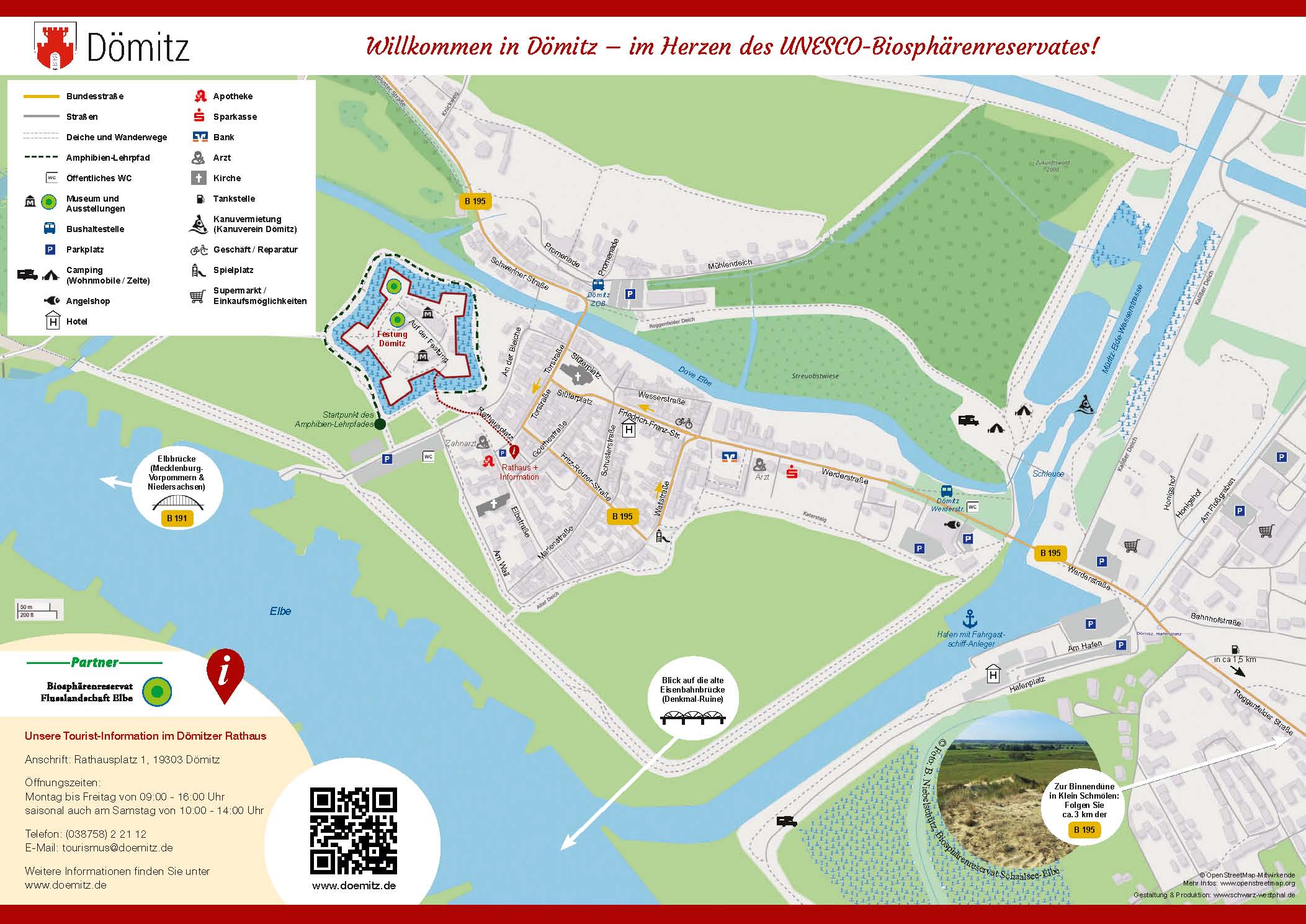Contact
Fortress Dömitz
Rathausplatz 1
Phone: (038758) 2 21 12
tourismus@doemitz.de
Webseite
The fortress Dömitz is the citadel of the former fortified ideal city of Dömitz. Built between 1559 and 1565, it is today the only fully preserved renaissance fortification in northern Germany. With FORTE CULTURA, discover the exciting history of the former border fortress on the Elbe, which later became a state penitentiary and in which Fritz Reuter, the most important Low German poet, spent the last year of his "Ut mine Festungtid" in 1839 - 1840. Elbe Market“ or atmospheric summer concerts. From the fortress dömitz, conquer the incomparable nature of the UNESCO Biosphere Reserve River Landscape Elbe Mecklenburg-Western Pomerania, which presents itself in the fortress with an information centre and exhibitions.
FORTE CULTURA® Travel Recommendations
Experience World
Dömitz Citadel
The citadel is a masterpiece of so-called Old Italian style and has a regular pentagon as a basic shape. At every corner there is a cannon-reinforced bastion: Kavalier, Held, Drachen, Greif and Burg. Insurmountable walls extend between the bastions, and a circular moat with an upstream embankment provides additional protection.
Commander's House in the Dömitz Citadel
The Commander's House is the largest and tallest building of the fortress. The striking building still contains parts of a medieval castle, on whose foundations the Renaissance fortress Dömitz was built.
Zeughaus (armoury) Citadel Dömitz
The former armoury of the fortress now houses the UNESCO Biosphere Reserve - permanent exhibition "Human and Biosphere - Yesterday, Today, Tomorrow" as well as other temporary special exhibitions on the subject.
Casemated bastions in the Dömitz Citadel
The enormous, fortified five bastions of the fortress Dömitz have been preserved. The casemates of the dragon and castle bastions can be visited as part of guided tours. Bastion Kavalier holds an information exhibition. The bastion Greif shows the multimedia exhibition "Im Grunde"(In the ground) of the UNESCO Biosphere Reserve.
Hauptwache (main guard) in the Dömitz Citadel
Today, the historical main guard houses exhibitions on the Low German writer Fritz Reuter as well as on the history of fortresses and the city. You will get an insight into the development and significance of the fortress town of Dömitz from the 16th to the 19th century. There is also a gallery where works by regional (hobby) artists can be seen regularly.
Counter scarp around the citadel, ramparts and moats
A 20-minute walk on the Kontereskarpe leads completely around the historical fortress. There is an optimal view of the fortress, its ramparts and moats and the biosphere reserve in which the flatland fortress is located.
Drawbridge Friedenstor (Peace Gate) to the Citadel Dömitz
On request, the small "fortress guard" demonstrates the function of the historic drawbridge.
Citadel courtyard with functional buildings and open-air stage
The fortress courtyard in the centre of the citadel, with its special ambience and an open-air stage, is today the site of various cultural events. These range from the "BiosphereElbe Market“ and the "North German Day" with artisan market to children's festivals to concerts of various genres as well as operas.
Fortified bridgehead of the railway bridge Dömitz
The fortified bridge house protected the second longest railway power bridge in Germany when it was built (1870 - 1873). It originally measured 1050 meters. Under the tower with tins and shooting ranges there are caste-matted vaults through which the Elbe cycle path passes. A total of 16 orphaned foreshore bridge arches and their defensive bridgehead on the western bank of the Elbe are today reminiscent of glorious railway times, the destruction of 1945 and the inner German demarcation, which prevented reconstruction. In 2018, the western bridgehead was renovated. A skywalk is to be built here in the future and make the UNESCO Biosphere Reserve River Landscape Elbe M-V experienceable from a new perspective.
Fortified ideal city Dömitz
The design and redevelopment of complete fortified cities with strictly geometric alimony layouts was one of the most extraordinary achievements of military strategists from the 16th to 18th centuries. The regular/ideal city geometries, already known by Greeks and often practiced by Romans, were developed with the modern bastion systems into highly effective city fortresses. The ideal fortress city united the military with all the necessary civilian crafts and services in the most effective way. Straight streets convey the harmony of the overall structure. Their striking axes of view, stylish silhouettes and often well-preserved defences are still an impressive work of art. These wonderfully even facilities with an extraordinary cityscape are today literally the "stars" of fortress architecture. Dömitz still impressively shows this original structure with a citadel. As a "fortified ideal city", Dömitz is thus a total work of art for the fortress, of which there are only five other cities in Germany (Hanau, Mannheim, Philippsburg, Saarlouis and Orsoy). among the masterpieces of this impressive fortress category. Among the fortresses on the Elbe, Terezin (CZ) is one of the masterpieces of this impressive category of fortresses.
Tour Offers and Information
Museum Fortress Dömitz
• Lecture on fortress and city history approx. 0.5 hours. € 35.00
Guides Tours and nature trails UNESCO-Biosphärenreservat Flusslandschaft ELBE-Mecklenburg Western Pomerania
Signposted circular routes with information boards, amphibious educational trail for Fortress Dömitz, Elbe valley dune path in Europe's largest inland dune near Klein Schmölen
Tourist information
Mediation of city and nature tours, tour guides, individual tourist services in the Elbe region Dömitz in a modular system
Map
Monument and History
History The oldest and most influential building in the city is the imposing lowland fortress. It is the only fully preserved Renaissance pentagonal fortress in northern Germany. The fortress was built under Duke Johann Albrecht I in the years 1559-1565 and was for a long time a strong military point to secure the Mecklenburg border. In the 18th century, a cane and toll house was built in the fortress, later the state penitentiary. The most important Low German poet, Fritz Reuter, spent the last year of his " Festungstid"(1839-1840) at the fortress of Dömitz. Reuters literary work has certainly helped the city to become known far beyond Mecklenburg's borders. Since 1895, the fortress has been subject to civilian use. In 1953, a museum on the history of the city and fortress was built in the former commander's house, and in the former fortress chapel in 1958 a Fritz Reuter memorial hall was built. Today, the fortress is an interesting excursion destination for several thousand tourists every year.
Quelle: © Jörg Reichel Quelle: Maler Theodor Schlöpke Quelle: gemeinfrei
Architecture The Pentagonal lowland fortress Dömitz was built between 1559 and 1565 under the Duke of Mecklenburg, Johann Albrecht I, with five bastions with casemates. He used Italian craftsmen for his Renaissance fortress under the direction of fortress engineer Francesco a Borno from Brescia. The commander's house, which initially served as a castle, still shows parts of the former buildings by a medieval castle. Other surviving buildings around the fortress courtyard are main guard house, armoury, detention center, commandant's dormitory and log house. It leads a path on the counter-escarp around the entire fortress and gives the view of the walls and trenches. Also noteworthy is the restored drawbridge system, whose function is regularly demonstrated during changing of the guard. The historic sandstone gate, which has also been extensively restored, is decorated with the coats of arms of Mecklenburg and Brandenburg in honour of the ducal wife Anna Sophie of Prussia. The bastions with the names Cavalier, Burg, Greif, Dragon and Held have also been preserved and can be visited as exhibition rooms and during guided tours. . Fortified ideal city Dömitz
Quelle: Stadt Dömitz ©Soeren Eberhardt-Biermann Quelle: Museum Festung Dömitz Quelle: ©AdobeStock_avtp.jpeg
Nature Experience The Renaissance fortress and also the former fortified ideal city of Dömitz are embedded in an eventful, still largely natural river landscape. The Elbe landscape is here breeding ground for more than 150 bird species and also in winter quarter of numerous waterfowl. Ornithologists, biologists and the rangers of the UNESCO Biosphere Reserve lead guests to the most interesting observation sites all year round as part of the event programme. UNESCO Biosphere Reserve River Landscape Elbe Mecklenburg-Western Pomerania Elberadweg (Elbe Cycle Path)
Quelle: Festung und Festungsstadt Dömitz© Marina Möller Quelle: © UNESCO Biosphärenreservat Flusslandschaft Elbe M.-V.
Quelle: © UNESCO Biosphärenreservat Flusslandschaft Elbe M.-V.
Partner




